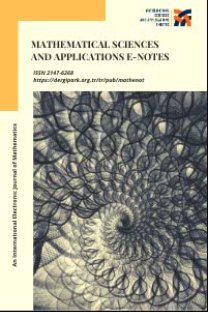Risk Measures of the ERNB Distribution Generated by G-NB Family
Erlang distiribution, the Erlang-Negative Binomial distribution, Value at Risk Conditional Value at Risk, G-NB family,
___
- [1] Jorion, P. Risk management lessons from long term capital management. European financial management, 6 (2000) No.3, 277-300.
- [2] Denuit M., Dhaene J. and, Goovaerts M.J., Kaas R. Actuarial Theory for Dependent Risks; Measures, Orders and Models, John Wiley and Sons, 2005.
- [3] Rockafellar, R. T., and Uryasev, S. . Conditional value-at-risk for general loss distributions. Journal of banking & finance, 26(2002), 7, 1443-1471.
- [4] Artzner, P., Delbaen, F., Eber, J. M., and Heath, D. . Coherent measures of risk. Mathematical finance, 9 (1999),3, 203-228.
- [5] Embrechts, P., Resnick, S. I., and Samorodnitsky, G. Extreme value theory as a risk management tool. North American Actuarial Journal, 3(1999), 2, 30-41.
- [6] Pflug, G. Some Remarks on the Value at Risk and the Conditional Value at Risk, in: S.P. Uryasev (ed.), Probabilistic Constrained Optimization: Methodology and Applications. Kluwer Academic Publishers, Dordrecht, Netherlands, pp. 272-281, 2000.
- [7] Krokhmal, P., Palmquist, J., and Uryasev, S. Portfolio optimization with conditional value-at-risk objective and constraints. Journal of risk, 4 (2002), 43-68.
- [8] Jiménez, J. A., and Arunachalam, V. . Using Tukey’sg and h family of distributions to calculate value-at-risk and conditional value-at-risk. Journal of Risk, 13 (2011), 4, 95-116.
- [9] Embrechts, P., Kluppelberg, S., and Mikosch, T. Extremal events in finance and insurance, 1997.
- [10] Rau-Bredow, H. Value at risk, expected shortfall, and marginal risk contribution. Risk Measures for the 21st Century, Szego, G.(ed.), Wiley Finance, 61-68, 2004.
- [11] Cummins, J. D., Dionne, G., McDonald, J. B., and Pritchett, B. M. Applications of the GB2 family of distributions in modeling insurance loss processes. Insurance: Mathematics and Economics, 9 (1990), 4, 257-272.
- [12] Dickson, D. C., and Hipp, C. On the time to ruin for Erlang (2) riskprocesses. Insurance: Mathematics and Economics, 29(2001), 3, 333-344.
- [13] Yuen, K. C., Guo, J., and Wu, X. On a correlated aggregate claims model with Poisson and Erlang risk processes. Insurance: Mathematics and Economics, 31(2002), 2, 205-214.
- [14] Lefèvre, C., and Picard, P. Appell pseudopolynomials and Erlang-type risk models. Stochastics An International Journal of Probability and Stochastic Processes, 86 (2014), 4, 676-695.
- [15] Straub, E. Swiss Association of Actuaries (Zürich). Non-life insurance mathematics (No. 517/S91n). Berlin: Springer, 1988.
- [16] Chen, S. X. Probability density function estimation using gamma kernels. Annals of the Institute of Statistical Mathematics, 52 (2000), 3, 471-480.
- [17] Lee, S. C., and Lin, X. S. Modeling and evaluating insurance losses via mixtures of Erlang distributions. North American Actuarial Journal, 14 (2010), 1, 107-130.
- [18] Jeon, Y., and Kim, J. H. A gamma kernel density estimation for insurance loss data. Insurance: Mathematics and Economics, 53 (2013), 3, 569-579.
- [19] Pascal B. Varia opera mathematica D.Petri de Fermat, Tolossae,1679.
- [20] Student. On the error of counting with a haemacytometer. Biometrika, (1907), 351-360.
- [21] Gómez-Déniz, E., Sarabia, J. M., and Calderín-Ojeda, E. Univariate and multivariate versions of the negative binomial-inverse Gaussian distributions with applications. Insurance: Mathematics and Economics, 42(2008), 1, 39-49.
- [22] Pudprommarat, C., Bodhisuwan, W., and Zeephongsekul, P. . A new mixed negative binomial distribution. Journal of Applied Sciences, 12 (2012),17, 1853.
- [23] Ramos, M. W. A., Percontini, A., Cordeiro, G. M., and da Silva, R. V. The Burr XII negative binomial distribution with applications to lifetime data. International Journal of Statistics and Probability, 4 (2015), 1, 109.
- [24] Kongrod S., Bodhisuwan W., Payakkapong P. The negative binomial-Erlang distribution with applications Introduction Journal of Pure and Applied Mathematics, 92 (2014), 3, 389-401.
- [25] Percontini, A., Cordeiro, G. M., and Bourguignon, M. The G-Negative Binomial Family: General Properties and Applications. Advances and Applications in Statistics, 35 (2013), 127-160.
- [26] Erlang A.K. Solution of some problems in the theory of probabilities of significance in automatic telephone exchanges. Elektrotkeknikeren, 13 (1917), 513.
- ISSN: 2147-6268
- Yayın Aralığı: 4
- Başlangıç: 2013
- Yayıncı: -
Münevver Yıldırım YILMAZ, Mehmet BEKTAŞ
Pakize TEMTEK, Nagehan Kılınç GEÇER
Süleyman ŞENYURT, Abdussamet ÇALIŞKAN
